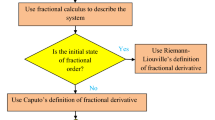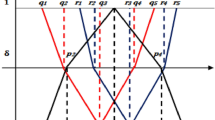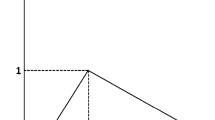Abstract
In this research work, an inventory model with fuzzy promotional effort induced dynamic demand under two level partial trade credit policy has been developed in an imprecise planning horizon. Here, it is assumed that in the planning horizon a retailer completed a finite number full cycles. In each of the retailer’s cycle, a wholesaler offers a credit period to the retailer on the full purchased amount and in turn the retailer offers a credit period to its customers on a part of his/her purchased amount. The imprecise marketing demand is influenced by the retailer’s fuzzy promotional effort, customers’ credit period, customers’ credit amount and retail selling price. Goal of this study is to find the optimal business strategy for the retailer with respect to his/her total fuzzy financial gain from the system. Due to imprecise nature of the demand, the problem is mathematically represented following fuzzy differential equation and fuzzy Riemann integration and alpha-cut of the entire fuzzy gain from the system is derived. Its graded mean integration representation is computed and optimized with respect to customer’s credit amount credit period, and retailer’s order quantity for most appropriate marketing decision. Hence, the problem reduced to a multivariate crisp optimization problem and a heuristic, multichoice artificial bee genetic algorithm (MCABGA) has been proposed for it. The efficiency of MCABGA is tested against some other existing artificial bee colony variants using a list of benchmark test functions available in the literature. The model is illustrated with some hypothetical test problems and some managerial insights are outlined. Finally, a conclusion is drawn and some future research directions are proposed.
Similar content being viewed by others
References
Aggarwal SP, Jaggi CK (1995) Ordering policies of deteriorating items under permissible delay in payments. J Oper Res Soc 46:658–662
Bera UK, Maiti MK, Maiti M (2012) Inventory model with fuzzy lead-time and dynamic demand over finite time horizon using a multi-objective genetic algorithm. Comput Math Appl 64:1822–1838
Buckley JJ, Feuring T (2000) Fuzzy differential equations. Fuzzy Sets Syst 110:43–54
Chalco-Cano Y, Roman-Flores H (2008) On new solutions of fuzzy differential equations. Chaos, Solitons Fractals 38(1):112–119
Chalco-Cano Y, Roman-Flores H (2009) Comparation between some approaches to solve fuzzy differential equations. Fuzzy Sets Syst 160:1517–1527
Chen SH, Hsieh CH (1999) Optimization of fuzzy back order inventory models. IEEE Int Fuzy Syst Conf (Seoul, Koria) Proc 1:240–244
Chen SH, Hsieh CH (2000) Representation, ranking, distance, and similarity of L-R type fuzzy number and application. Aust J Intell Process Syst 6:217–229
Chung KJ (2011) The simplified solution procedures for the optimal replenishment decisions under two level trade credit policy depending on the order quantity in a supply chain system. Expert Syst Appl 38:13482–13486
Chung KJ (2013) The EPQ model under conditions of two levels of trade credit and limited storage capacity in supply chain management. Int J Syst Sci 44:1675–1691
Chung KJ, Liao JJ (2004) Lot-size decisions under trade credit depending on the ordering quantity. Comput Oper Res 31:909–928
De SK, Goswami A (2006) An EOQ model with fuzzy inflation rate and fuzzy deterioration rate when a delay in payment is permissible. Int J Syst Sci 37(5):323–335
De PK, Rawat A (2013) Optimal order quantity of an EOQ model using expected value of a fuzzy function. IEEE Int Conf Fuzzy Syst (FUZZ-IEEE). https://doi.org/10.1109/FUZZ-IEEE.2013.6622534
De SK, Sana SS (2016) An EOQ model with backlogging. Int J Manag Sci Eng Manag 11(3):143–154
Dubois D, Prade H (1980) Fuzzy sets and systems: theory and applications. Academic Press, New York
Gao WF, Liu SY (2012) A modified artificial bee colony algorithm. Comput Oper Res 39:687–697
Gao WF, Liu SY, Huang LL (2013) A novel artificial bee colony algorithm based on modified search equation and orthogonal learning. IEEE Trans Cybern 43:1011–1024
Garai T, Chakraborty D, Roy TK (2017) Expected value of exponential fuzzy number and its application to multi-item deterministic inventory model for deteriorating items. J Uncertain Anal Appl. https://doi.org/10.1186/s40467-017-0062-7
Goyal SK (1985) Economic order quantity under conditions of permissible delay in payment. J Oper Res Soc 36:335–338
Guchhait P, Maiti MK, Maiti M (2013) A production inventory model with fuzzy production and demand using fuzzy differential equation: an interval compared genetic algorithm approach. Eng Appl Artif Intell 26:766–778
Guchhait P, Maiti MK, Maiti M (2014) Inventory model of a deteriorating item with price and credit linked fuzzy demand : a fuzzy differential equation approach. OPSEARCH 51:321–353
Guchhait P, Maiti MK, Maiti M (2015) An EOQ model of deteriorating item in imprecise environment with dynamic deterioration and credit linked demand. Appl Math Model 39(21):6553–6567
He Y, Zhao X, Zhao L, He J (2009) Coordinating a supply chain with effort and price dependent stochastic demand. Appl Math Model 33:2777–2790
Ho CH (2011) The optimal integrated inventory policy with price-and-credit linked demand under two-level trade credit. Comput Ind Eng 60:117–126
Huang YF (2003) Optimal retailer’s ordering policies in the EOQ model under trade credit financing. J Oper Res Soc 54:1011–1015
Huang YF (2006) An inventory model under two levels of trade credit and limited storage space derived without derivatives. Appl Math Model 30:418–436
Huang YF (2007) Economic order quantity under conditionally permissible delay in payments. Eur J Oper Res 176:911–924
Huang YF, Hsu KH (2008) An EOQ model under retailer partial trade credit policy in supply chain. Int J Prod Econ 112:655–664
Ishii H, Konno T (1998) A stochastic inventory problem with fuzzy shortage cost. Eur J Oper Res 106:90–94
Kandal A, Bytt WJ (1978) Fuzzy differential equation. In: Proceedings of international conference on cybernetics society, Tokyo, pp 1213–1216
Kandal A, Bytt WJ (1980) Fuzzy processes. Fuzzy Sets Syst 4:117–152
Kao C, Hsu WK (2002) A single-period inventory model with fuzzy demand. Comput Math Appl 43(6–7):841–848
Karaboga D (2015) An idea based on honey bee swarm for numerical optimization. Technical report-TR06, Erciyes University, Kayseri, Turkey
Karaboga D, Akay B (2009) A comparative study of artificial bee colony algorithm. Appl Math Comput 214:108–132
Karaboga D, Basturk B (2007) A powerful and efficient algorithm for numerical function optimization: artificial bee colony (ABC) algorithm. J Glob Optim 39:459–471
Karaboga D, Basturk B (2008) On the performance of artificial bee colony (ABC) algorithm. Appl Soft Comput 8:687–697
Katagiri H, Ishii H (2000) Some inventory problems with fuzzy shortage cost. Fuzzy Sets Syst 111:87–97
Katagiri H, Ishii H (2002) Fuzzy inventory problems for perishable commodities. Eur J Oper Res 138:545–553
Kiran MS, Hakli H, Gundaz M, Uguz H (2015) Artificial bee colony algorithm with variable search strategy for continuous optimization. Inf Sci 300:140–157
Kundu A, Guchhait P, Pramanik P, Maiti MK, Maiti M (2017) A production inventory model with price discounted fuzzy demand using an interval compared hybrid algorithm. Swarm Evol Comput 34:1–17
Liu B (2002) Theory and practice of uncertain programming. Physica, Heidelberg
Liu B, Iwamura K (1998) Chance constrained programming with fuzzy parameters. Fuzzy Sets Syst 94:227–237
Mahata GC (2012) An EPQ-based inventory model for exponentially deteriorating items under retailer partial trade credit policy in supply chain. Expert Syst Appl 39:3537–3550
Mahata GC, De SK (2016) An EOQ inventory system of ameliorating items for price dependent demand rate under retailer partial trade credit policy. OPSEARCH. https://doi.org/10.1007/s12597-016-0252-y
Maiti MK (2008) Fuzzy inventory model with two warehouses under possibility measure on fuzzy goal. Eur J Oper Res 188(3):746–774
Maiti MK (2011) A fuzzy genetic algorithm with varying population size to solve an inventory model with credit-linked promotional demand in an imprecise planning horizon. Eur J Oper Res 213:96–106
Maiti MK, Maiti M (2006) Fuzzy inventory model with two warehouses under possibility constraints. Fuzzy Sets Syst 157(1):52–73
Maiti MK, Maiti M (2007) Two-storage inventory model with lot-size dependent fuzzy lead-time under possibility constraints via genetic algorithm. Eur J Oper Res 179:352–371
Mandal NK, Roy TK, Maiti M (2005) Multi-objective fuzzy inventory model with three constraints: a geometric programming approach. Fuzzy Sets Syst 150(1):87–106
Michalewicz Z (1992) Genetic algorithms + data structures = evolution programs. Springer, Berlin
Ouyang LY, Ho CH, Su CH (2008) Optimal strategy for an integrated system with variable production rate when the freight rate and trade credit are both linked to order quantity. Int J Prod Econ 115:151–162
Ouyang LY, Teng JT, Goyal SK, Yang CT (2009) An economic order quantity model for deteriorating items with partially permissible delay in payments to order quantity. Eur J Oper Res 194:418–431
Pal B, Sana SS, Chaudhuri K (2015) Coordination contracts for competitive two-echelon supply chain with price and promotional effort sensitive non-linear demand. Int J Syst Sci Oper Logist 2(2):113–124
Pramanik P, Maiti MK (2019a) An inventory model for deteriorating items with inflation induced variable demand under two level partial trade credit: a hybrid ABC-GA approach. Eng Appl Artif Intell 85:194–207
Pramanik P, Maiti MK (2019b) An inventory model with variable demand incorporating unfaithfulness of customers under two-level trade credit. Eur J Ind Eng 13(4):461–488. https://doi.org/10.1504/EJIE.2019.100957
Pramanik P, Maiti MK, Maiti M (2017a) An appropriate business strategy for a sale item. OPSEARCH. https://doi.org/10.1007/s12597-017-0310-0
Pramanik P, Maiti MK, Maiti M (2017b) A supply chain with variable demand under three level trade credit policy. Comput Ind Eng 106:205–221
Pramanik P, Maiti MK, Maiti M (2017c) Three level partial trade credit with promotional cost sharing. Appl Soft Comput 58:553–575
Pramanik P, Malik Das S, Maiti MK (2019) Note on: supply chain inventory model for deteriorating items with maximum lifetime and partial trade credit to credit risk customers. J Ind Manag Optim 15(3):1289–1315
Raula P, Indrajitsingha SK, Samanta PN, Misra UK (2016) A fuzzy inventory model for constant deteriorating item by using GMIR method in which inventory parameters treated as HFN. Open J Appl Theor Math (OJATM) 2(1):13–20
Roman-Flores H, Barros L, Bassanezi R (2001) A note on the Zadeh’s extensions. Fuzzy Sets Syst 117:327–331
Roy A, Maiti MK, Kar S, Maiti M (2007) Two-storage inventory model with fuzzy deterioration over a random time horizon. Math Comput Model 46:1419–1433
Sarkar S, Chakrabarti T (2012) An EPQ model with two-component demand under fuzzy environment and Weibull distribution deterioration with shortages. Adv Oper Res. https://doi.org/10.1155/2012/264182
Teng JT (2009) Optimal ordering policies for a retailer who offers distinct trade credits to its good and bad customers. Int J Prod Econ 119:415–423
Vorobiev D, Seikkala S (2002) Towards the fuzzy differential equations. Fuzzy Sets Syst 125:231–237
Wee HM (1999) Deteriorating inventory model with quantity discount, pricing and partial backordering. Int J Prod Econ 59:511–518
Wee HM, Lo CC, Hsu PH (2009) A multi-objective joint replenishment inventory model of deteriorated items in a fuzzy environment. Eur J Oper Res 197:620–631
Wu HC (2000) The fuzzy Riemann integral and its numerical integration. Fuzzy Sets Syst 110:1–25
Zadeh LA (1965) Fuzzy sets. Inf. Control 8:338–356
Zadeh LA (1978) Fuzzy sets as a basis for a theory of possibility. Fuzzy Sets Syst 1:3–28
Zhu G, Kwong S (2010) Gbest-guided artificial bee colony algorithm for numerical function optimization. Appl Math Comput 217:3166–3173
Acknowledgements
There is no funding regarding this research work.
Author information
Authors and Affiliations
Corresponding author
Ethics declarations
Conflict of interest
The authors declares that they have no conflict of interest.
Ethical approval
This article does not contain any studies with human participants or animals performed by any of the authors.
Additional information
Communicated by V. Loia.
Publisher's Note
Springer Nature remains neutral with regard to jurisdictional claims in published maps and institutional affiliations.
Appendices
Appendix A
The GMIR value of the \(\alpha \)-cut of a fuzzy number \(\widetilde{Z}\) and is given by Eq. (45).

\(\hbox {HOC}\), IP, IE and \(\hbox {PRC}\), respectively, represent the GMIR value of \(\widetilde{\hbox {HOC}}[\alpha ]\), \(\widetilde{IP}[\alpha ]\), \(\widetilde{IE}[\alpha ]\), and \(\widetilde{\hbox {PRC}}[\alpha ]\), where
Appendix B
For any crisp number Q and the triangular fuzzy number \(\widetilde{D}=(d_1,d_2,d_3)\), by Eq. (15) the retailer’s cycle length became a fuzzy number \(\widetilde{T}\) and hence \(n\,\widetilde{T}\) is also a fuzzy number. The membership function of the fuzzy number \(\widetilde{nT}\) is presented by Eq. (50).
According to the definition of possibility and necessity measure (Zadeh 1978; Dubois and Prade 1980), for any two fuzzy numbers \(\widetilde{nT}\) and \(\widetilde{H}\), \(\hbox {Pos}(\widetilde{NT}\le \widetilde{H})\) and \(\hbox {Nes}(\widetilde{NT}\le \widetilde{H})\) are, respectively, given by Eqs. (51) and (52).


where \(\eta _1\) (cf. Fig.-1) and \(\eta _2\) are, respectively, given by Eqs. (53) and (54).
Using Eqs. (51) and (52), according to Liu (2002), the credibility measure of the fuzzy event \(\widetilde{NT}\le \widetilde{H}\) is given by Eq. (55).
Rights and permissions
About this article
Cite this article
Pramanik, P., Maiti, M.K. Trade credit policy of an inventory model with imprecise variable demand: an ABC-GA approach. Soft Comput 24, 9857–9874 (2020). https://doi.org/10.1007/s00500-019-04502-5
Published:
Issue Date:
DOI: https://doi.org/10.1007/s00500-019-04502-5





